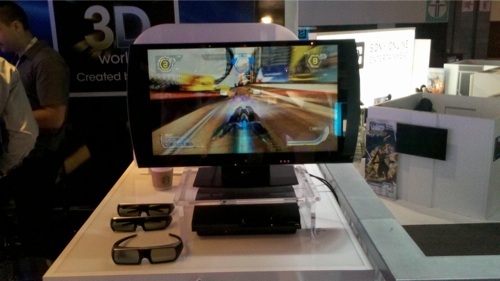
Ed, will you quit messing with those guys and get over here!?
So, currently, there's kind of a stalemate between couch co-op and online. The two are evenly tied in that they each do things the other can't. For my money, couch co-op is infinitely more enjoyable, when I can get it. But when I can't, then I'm very glad I have a good wireless connection.
But what does the future hold for couch co-op? Well, we can't say for sure what will come to pass, but we do have some hopes for what we'd like to see. The advent of 3D televisions is very exciting, because it presents a unique opportunity for couch co-op. In times past, as we've discussed, couch co-op has always been presented on the same screen in one of two ways: The classic split-screen play, in which the screen is split either horizontally, or in some cases, vertically and each player is given their own individual screen within the television that they use to play,, and the same-screen co-op in games such as Fable, in which two players share the same screen and the camera angle zooms and moves away so that both character models can be accommodated. Each of these methods have their downfalls, however; split-screen ends up decreasing the player's field of vision or otherwise distorting the image in unpleasant ways, which can decrease the ease of play significantly. Same-screen co-op can be troublesome in that if the two players get far away from one another, the screen zooms too far out. Some games combat this with limiting player movement to a certain distance within each other, constraining their mobility in the interest of keeping the players close. I know I for one have had to tell a friends many times to hustle up and get to my part of the screen so that we could go to the next room, already.

Where 3D televisions come in is in their method of presenting the third dimension. In order to present a full 3D image to the player, the television actually has two screens, working in close tandem to present two images which are parallax to one another. This false parallax then tricks the eye into perceiving real depth, which gives us the 3D image. So what we have is, in essence, two full-frame presentations of the same game happening one one screen. Alternately, some TVs use a different sort of tech implementing special glasses - the same kind that costs you an extra three dollars at the multiplex. These glasses look now like 2 identical sheets of plastic, but they are actually two separate filters. The left lens filters out images that are presented in one wavelength on the screen, while the right filters out another - which again, creates a false parallax and bamboozles your optic nerve into seeing depth where there is none. These glasses used to be in Red and blue when I was young (which I know is dating myself a bit), but now the images are clear, as are the glasses, allowing for a full, vivid colour spectrum.
This is all very technical, but what this means for gamers is that applying this technology, a special screen or special series of glasses can be made so that either you sitting at the proper angle will filter out the other player's image entirely, or wearing glasses with only one set of lenses will filter out the other player's screen. Meaning you can theoretically have two full-screen images on a television which are entirely independent of one another. You and a friend can play some games one one TV and not have your vision limited or your movement restrained. There's still the problem of shared audio, but two separate sound output channels and some headphones can mitigate that. In fact, This technology has been put to use by Sony, who released a TV with a technololgy they call “SimulView” technology (which is essentially the technique we discussed using glasses. LG is also planning to release a TV with a simlilar technology. We can only hope more developers make use of the idea.

Sorry, Mitch.
Another hope that can be addressed with current (read: non-imaginary) methods is that of mutual benefit to couch co-op gaming. Some games, such as the Fable series (which I must say is taking it's rightful pounding in this article) only measure real progress for one player. In Fable 2, co-op was available, but not widely used. This is because the second player could receive no achievements, gear, or story progress in their own, making it about as stimulating and sought-after as a sphincter on your elbow. So for both players to play through the game together and get all relevant weapons and cheevos, you had to do all the work. TWICE. This is impractical because (as I can tell you from personal experience) Once one player has reaped the benefits of co-op play, their incentive to help their friend can disappear, and someone gets left hanging to the tune of several hundred gamer points.
This is the sort of thing that developers have the power to change. It's as simple as implementing a server-side memory for game progress and item drops. A server-side tally of gamerscore exists, but that requires account recovery on someone else's Xbox, which even now takes a startlingly long time.
But as it goes, I'm very happy with the current state if co-op gaming. It's in no risk of going anywhere, because everywhere there are gamers with friends, there will be gaming with friends. Whether you play online or on the same couch, you gotta love owning some chumps with your pal as the co-pilot on your magical journey of killing dudes.